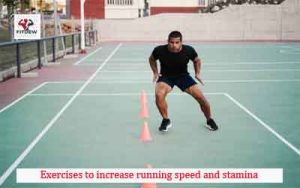If you are a passionate runner looking to take your performance to the next level, understand the fact that there is more to it than just hitting the pavement and putting in miles.
Speed and stamina in running are essential components of a successful running journey. Add to your workout routine specific exercises that can help you achieve these goals.
In today’s post, we will explore a range of exercises to increase running speed and stamina. Read till the last dot to get the information you need about the workouts.
While working out, ensure you don’t do any of the exercise mistakes. Check out our post on the most common exercise mistakes. Now, let’s talk about the benefits of enhanced speed and stamina.

Benefits of increasing running speed and stamina
Running is a timeless and accessible form of exercise that has captivated fitness enthusiasts for generations.
Whether you are a seasoned athlete or just starting your fitness journey, enhancing your running speed and stamina can bring advantages to your physical and mental well-being. If you are new to running, check out our post on the Best Running Tips for Beginners.
Here are the advantages of enhancing running speed and stamina.
- Improved Cardiovascular Health
One of the most significant benefits of enhancing your running speed and stamina is the positive impact it has on your cardiovascular system.
Regular, challenging runs increase your heart rate and strengthen the heart muscle, making it more efficient at pumping blood. This lowers your risk of heart disease, reduces blood pressure, and improves overall cardiovascular health.
- Weight Management
Running at higher speeds and for longer distances burns a substantial amount of calories.
Increasing your running capacity can assist with weight management and weight loss. As you push your limits, you will burn more calories, even at rest, as a result of an increased metabolic rate.
- Increased Endurance
Building stamina through running enables you to run longer distances and also boosts your endurance in other physical activities. Enhanced endurance can lead to better performance in various sports and daily tasks, making you less fatigued during the day.
- Mental Resilience
Running is not just about physical strength; it is also a mental challenge. As you work on increasing your speed and stamina, you will develop mental resilience, discipline, and determination. This mental toughness can extend beyond running and positively impact various aspects of your life.
- Stress Reduction
Running is an excellent stress reliever. When you push yourself to new running goals, your body releases endorphins which are natural mood lifters. The rhythm of running can also provide a meditative quality, which allows you to clear your mind and reduce stress.
- Better Sleep
Regular exercise including running can enhance the quality of your sleep. It assists in regulating your circadian rhythm, and also reduces anxiety, and allows you to fall asleep faster and enjoy deeper, more restful slumber.
- Enhanced Self-Esteem
Setting and achieving running goals like running faster or longer distances, can significantly enhance your self-esteem and self-confidence. This sense of accomplishment can carry over into other areas of your life, inspiring you to tackle challenges with confidence.
- Social Opportunities
Running can be a social activity also. Joining running clubs or participating in races can introduce you to like-minded individuals and expand your social network. The camaraderie of a running group can be a powerful motivator.
- Longevity
Regular running has been associated with a longer and healthier life. By improving your cardiovascular health, reducing the risk of chronic diseases, and enhancing overall fitness, you are more likely to enjoy a longer and more active life.

Exercises to increase running speed and stamina
Let’s check out the workouts you can engage in to enhance your running speed and stamina.
- Interval Training
Interval training is a powerful method to improve both speed and stamina. It involves alternating between high-intensity sprints and low-intensity recovery periods.
For example, you can sprint for 30 seconds, followed by a 1–2-minute slow jog or walk. Repeat this cycle several times. This type of training assists your body to adapt to running at a faster pace and enhances your cardiovascular fitness.
- Hill Sprints
Hill sprints are an excellent way to build leg strength and enhance your running speed. Find a steep hill and sprint to the top, then walk or jog back down for recovery. Repeating this exercise can enhance your running power and speed on flat terrain.
- Plyometric Exercises
You can engage in plyometric exercises like box jumps, squat jumps, and bounding into your routine. These exercises enhance your explosive strength and agility, making your strides more powerful and efficient.

- Tempo Runs
Tempo runs involve running at a comfortably hard pace, typically at or just below your lactate threshold.
This type of workout assists you to improve your running endurance, allowing you to maintain a faster pace for a longer duration.
- Long Slow Distance (LSD) Runs
While speed is important, building stamina is equally crucial. LSD runs involve running at a slow and steady pace for an extended period. These runs enhance your cardiovascular fitness, making it easier to endure long-distance races.
- Core Strengthening
A strong core stabilizes your posture and prevents wasted energy during your runs. Engaging in exercises like planks, Russian twists, and leg raises helps in strengthening your core muscles.

- Cross-Training
Cross-training activities such as swimming, cycling, or yoga can help prevent overuse injuries and improve overall fitness. They can also contribute to your stamina and speed by targeting different muscle groups.
- Fartlek Training
Fartlek, which means speed play in Swedish involves mixing short bursts of speed within your regular run. This method keeps your body guessing and assists in improving both speed and stamina.
- High-Intensity Interval Training (HIIT)
HIIT workouts can be adapted for runners by engaging in running sprints and other bodyweight exercises. These sessions are short but intense and assist in improving cardiovascular capacity and speed.

- Rest and Recovery
Adequate rest and recovery are essential for growth and performance. Make sure you allow your body time to recover between intense workouts to prevent overtraining and injuries.
Remember to drink enough water while working out. Don’t underestimate the benefits of drinking water to stay hydrated during exercise. you can check out our post on the Importance of hydration during exercise.
Conclusion on Exercises to Increase Running Speed and Stamina
To become a faster and more enduring runner, it is essential to add a variety of exercises into your training routine.
Combining interval training, hill sprints, plyometrics, tempo runs, LSD runs, core strengthening, cross-training, fartlek training, HIIT, and proper rest and recovery will assist you in achieving your running goals.
Consistency is key, so stick to your training plan and you will see significant improvements in both your running speed and stamina over time.
Frequently Asked Questions (FAQs) on Exercises to Increase Running Speed and Stamina
- What are the key exercises to increase running speed and stamina?
Key exercises include interval training, tempo runs, hill sprints, strength training, and aerobic workouts. These help in enhancing both your speed and endurance.
- What is interval training and how does it assist with running speed and stamina?
Interval training involves alternating between high-intensity sprints and low-intensity recovery periods. This helps increase your cardiovascular capacity, speed, and overall stamina.
- How do tempo runs benefit my running performance?
Tempo runs involve running at a comfortably hard pace for an extended period. They enhance your lactate threshold, making it easier to maintain a faster pace for longer periods.
- Why is hill running important for runners?
Running uphill engages different muscle groups and builds strength and power. It enhances your stamina and assists you to become a more efficient runner.
- Should I add strength training to my running routine?
Yes, strength training is crucial. It helps improve running economy, prevent injuries, and enhance overall stamina. Focus on exercises that target your legs, core, and upper body.
- How often should I do aerobic workouts for better stamina?
Aerobic workouts should be a consistent part of your training. Aim for at least 3-4 times a week. Activities like cycling, swimming, and rowing can complement your running routine.
Editor’s Picks
15 exercises that burn the most calories
Agility training for soccer players
10 Best Gym Exercises for Stress Relief and Relaxation (A must read for everyone)
4 comments
Comments are closed.